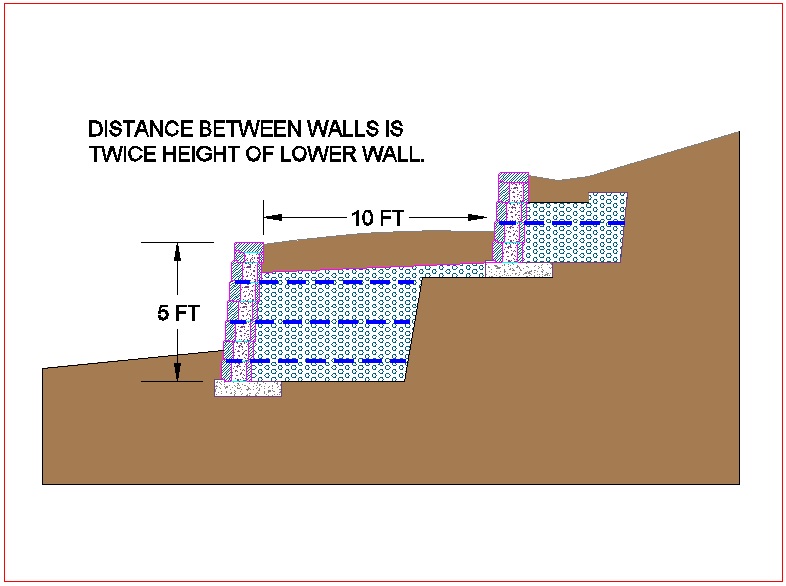HEREISTITLE
0HEREISCONTENT
HEREISCONTENT
When one retaining wall is constructed above another retaining wall, the two walls together are called a Tiered Wall System. Tiered walls look like this:
Distance Between Tiers:
Extra loads on a retaining wall are called surcharges. Retaining wall contractors understand that as the Upper Wall gets closer to the Lower Wall there is more load (more surcharge) put on the Lower Wall. If the Upper Wall is far away, then there is less load (less surcharge) put on the Lower Wall.
Question: How far away must the Upper Wall be so that it will not surcharge the Lower Wall? Answer: Take the height of the Lower Wall and double that number. That is how far away the Upper Wall must be to apply little to no surcharge on the Lower Wall. For example, if the Lower Wall is five (5) feet high, then the Upper Wall must be at least 10 feet back from the Lower Wall so it won’t overload the Lower Wall. (This assumes that the Lower Wall is taller than the Upper Wall.) See this drawing:

Joseph Kowalski, P.E.
www.RetainingWallNetwork.com
Current State PE Registrations
*National Concrete Masonry Association, Design Manual for Segmental Retaining Walls, Third Edition, Fifth Printing, 2010, Copyright NCMA, Herndon, VA.
Obviously, retaining wall design involves contracts. These contracts between the Engineer and the Client are important. Does the contract benefit both parties? Is using contracts a win-win?
Contracts are important to:
A good contract fairly allocates reasonable risk to both parties, based on the benefits of the project to each party.
Here’s an example of fair allocation of reasonable risk: when the contract includes a Limitation of Liability for the Engineer. Why, you might ask, am I limiting the Engineer’s liability and how is that fair?
Well, here’s how it is fair: The Engineer doesn’t demand an Unlimited Fee. With an unlimited fee comes unlimited liability. With a limited fee there is limited liability.
Sounds fair to me. What do you think?

Retaining wall expert project Number 13007 included several retaining walls in Easley, South Carolina.